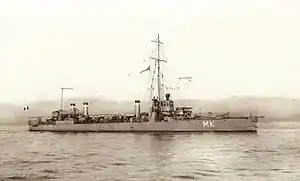French destroyer Mameluk (1909)
Mameluck was one of seven Spahi-class destroyers built for the French Navy in the first decade of the twentieth century.
 Mameluk at anchor | |
| History | |
|---|---|
| Name: | Mameluck |
| Namesake: | Mameluke |
| Builder: | Ateliers et Chantiers de la Loire, Nantes |
| Launched: | 10 March 1909 |
| Completed: | June 1911 |
| Stricken: | February 1928 |
| General characteristics | |
| Class and type: | Spahi-class destroyer |
| Displacement: | 530–550 t (522–541 long tons) |
| Length: | 65.8 m (215 ft 11 in) (p/p) |
| Beam: | 6.6 m (21 ft 8 in) |
| Draft: | 2.4 m (7 ft 10 in) |
| Installed power: |
|
| Propulsion: | 2 shafts; 2 triple-expansion steam engines |
| Speed: | 28 knots (52 km/h; 32 mph) |
| Range: | 1,000–1,200 nmi (1,900–2,200 km; 1,200–1,400 mi) at 10 knots (19 km/h; 12 mph) |
| Complement: | 77–79 |
| Armament: |
|
Design and description
The Spahi-class was over 50 percent larger than the preceding Branlebas class to match the increase in size of foreign destroyers.[1] Mameluk had an length between perpendiculars of 65.8 meters (215 ft 11 in), a beam of 6.6 meters (21 ft 8 in),[2] and a draft of 2.4 meters (7 ft 10 in). The ships displaced 530–550 metric tons (522–541 long tons) at deep load. Their crew numbered 77–79 officers and men.[1]
Mameluk was powered by two triple-expansion steam engines, each driving one propeller shaft using steam provided by four du Temple boilers. The engines were designed to produce 7,500 indicated horsepower (5,600 kW) which was intended to give the Spahi class a speed of 28 knots (52 km/h; 32 mph). During her sea trials, Mameluk reached a speed of 29.75 knots (55.10 km/h; 34.24 mph). The ships carried enough coal to give them a range of 1,000–1,200 nautical miles (1,900–2,200 km; 1,200–1,400 mi) at a cruising speed of 10 knots (19 km/h; 12 mph).[3]
The primary armament of the Spahi-class ships consisted of six 65-millimeter (2.6 in) Modèle 1902 guns in single mounts, one each fore and aft of the superstructure and the others were distributed amidships. They were also fitted with three 450-millimeter (17.7 in) torpedo tubes. One of these was in a fixed mount in the bow and the other two were on single rotating mounts amidships.[1]
Construction and career
Mameluk was ordered from Ateliers et Chantiers de la Loire and was launched at their shipyard in Nantes on 13 March 1908. She was completed in June 1911.[4]
Tasked with escort duties in the Mediterranean Mameluck was assigned to the 1st Squadron in June 1911, and a year later she was assigned to the 2nd Destroyer Squadron, of the 1st Fleet. In March 1913 she was assigned to torpedo squadron patrols and to support submarines in the Adriatic.[5]
During World War I, Mameluck rammed the French destroyer Fantassin in the Ionian Sea on 5 June 1915, so badly damaging Fantassin that the French destroyer Fauconneau consequently scuttled her.[6]
In 1916, Mameluck escorted the submarines Faraday and Le Verrier to Milo.[5] On 14 December 1917, along with Lansquenet, she sank the Imperial German Navy U-boat UC-38 off Cape Ducato in the Ionian Sea after the submarine torpedoed and sunk the French protected cruiser Châteaurenault.[5]
Mameluck was sold for scrap in 1928.[5]
Citations
- Gardiner & Gray, p. 202
- Couhat, p. 95
- Couhat, pp. 95–96
- Couhat, p. 96
- "MAMELUCK - Contre-torpilleur - marine - Forum Pages d'Histoire: marine - FORUM pages 14-18". pages14-18.mesdiscussions.net. Retrieved 29 June 2010.
- "French Navy". Naval History. Retrieved 21 February 2013.
Bibliography
- Couhat, Jean Labayle (1974). French Warships of World War I. London: Ian Allan. ISBN 0-7110-0445-5.
- Gardiner, Robert & Gray, Randal (1985). Conway's All The World's Fighting Ships 1906–1921. London: Conway Maritime Press. ISBN 0-85177-245-5.
- Roche, Jean-Michel (2005). "Classement par types". Dictionnaire des bâtiments de la flotte de guerre française de Colbert à nos jours 2, 1870 - 2006. Toulon: Roche. ISBN 978-2-9525917-0-6. OCLC 165892922.